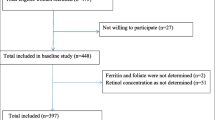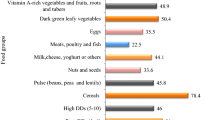Abstract
Purpose
The aim of this study is to examine the co-occurrences of low serum ferritin and zinc and anaemia among mothers and their children in two agro-ecological zones of rural Ethiopia.
Methods
Data were collected from 162 lactating mothers and their breast fed children aged 6–23 months. The data were collected via a structured interview, anthropometric measurements, and blood tests for zinc, ferritin and anaemia. Correlation, Chi-square and multivariable analysis were used to determine the association between nutritional status of mothers and children, and agro-ecological zones.
Results
Low serum levels of iron and zinc, anaemia and iron deficiency anaemia were found in 44.4, 72.2, 52.5 and 29.6% of children and 19.8, 67.3, 21.8, 10.5% of mothers, respectively. There was a strong correlation between the micronutrient status of the mothers and the children for ferritin, zinc and anaemia (p < 0.005). Deficiency in both zinc and ferritin and one of the two was observed in 19.1, and 53.7% of the mothers and 32.7 and 46.3%, of their children, respectively. In the 24 h before the survey, 82.1% of mothers and 91.9% of their infants consumed foods that can decrease zinc bioavailability while only 2.5% of mothers and 3.7% of their infants consumed flesh foods.
Conclusion
This study shows that micronutrient deficiencies were prevalent among lactating mothers and their children, with variation in prevalence across the agro-ecological zones. This finding calls for a need to design effective preventive public health nutrition programs to address both the mothers’ and their children’s needs.
Similar content being viewed by others
References
FAO/WHO (1992) International conference on nutrition. World declaration and plan of action. FAO, Rome
Kent JC (2007) How breastfeeding works. J Midwifery Womens’ Health 52:564–570. doi:10.1016/j.jmwh.2007.04.007
Allen LH (1993) The nutrition CRSP: what is marginal malnutrition, and does it affect human function? Nutr Rev 51:255–267
Christian P, West KP Jr (1998) Interactions between zinc and vitamin A: an update. Am J Clin Nutr 68:435S–441S
Whittaker P (1998) Iron and zinc interactions in humans. Am J Clin Nutr 68:442S–446S
Singh M (2004) Role of micronutrients for physical growth and mental development. Indian J Pediatr 71:59–62
Bitanihirwe BK, Cunningham MG (2009) Zinc: the brain’s dark horse. Synapse 63:1029–1049
Solomons NW, Jacob R (1981) Studies on the bioavailability of zinc in humans: effects of heme and nonheme iron on the absorption of zinc. Am J Clin Nutr 34:475–482
Hurtado EK, Claussen AH, Scott KG (1999) Early childhood anemia and mild or moderate mental retardation. Am J Clin Nutr 69:115–119
Idjradinata P, Pollitt E (1993) Reversal of developmental delays in iron-deficient anemic infants treated with iron. Lancet 341(8836):1–4
Brown KH (1998) Effect of infections on plasma zinc concentration and implications for zinc status assessment in low-income countries. Am J Clin Nutr 68:425S–429S
Brown KH, Wuehler SE, Peerson JM (2001) The importance of zinc in human nutrition and estimation of the global prevalence of zinc deficiency. Food Nutr Bull 22:113–125
Umeta M, West CE, Haidar J, Deurenberg P, Hautvast JG (2000) Zinc supplementation and stunted infants in Ethiopia: a randomised controlled trial. Lancet 355:2021–2026
A2Z, FANTA project (2006) Maternal anemia: a preventable killer. http://www.aed.org/Publications/upload/FANTAanemia2006.pdf. Accessed on May 2014
Kalaivani K (2009) Prevalence & consequences of anaemia in pregnancy. Indian J Med Res 130:627–633
Kassu A, Yabutani T, Mulu A, Tessema B, Ota F (2008) Serum zinc, copper, selenium, calcium, and magnesium levels in pregnant and non-pregnant women in Gondar, Northwest Ethiopia. Biol Trace Elem Res 122(2):97–106
Gebremedhin S (2011) Prevalence of prenatal zinc deficiency and its association with socio-demographic, dietary and health care related factors in Rural Sidama, Southern Ethiopia: a crosssectional study. BMC Public Health 11:1
Umeta M, Haidar J, Demissie T, Akalu G, Ayana G (2008) iron deficiency anaemia among women of reproductive age in nine administrative regions of Ethiopia. Ethiop J Health Dev 22:252–258
Haidar J, Muroki NM, Omwega AM, Ayana G (2003) Malnutrition and iron deficiency in lactating women in urban slum communities from Addis Ababa, Ethiopia. East Afr Med J 80:191–194
Woldie H, Kebede Y, Tariku A (2015) Factors associated with anemia among children aged 6–23 months attending growth monitoring at Tsitsika Health Center, Wag-Himra Zone, Northeast Ethiopia. J Nutr Metab 2015. doi:10.1155/2015/928632
EDHS (2012) Central Statistical Authority, ORC Macro: Ethiopia demographic and health survey. CSA and ORC, Addis Ababa, Ethiopia and Calverton, Maryland, USA
Gebreegziabiher G, Etana B, and Niggusie D (2014) Determinants of anemia among children aged 6–59 months living in Kilte Awulaelo Woreda, Northern Ethiopia J Anaemia 2014:245870. doi:10.1155/2014/245870
IZiNCG (2004) Assessment of the risk of zinc deficiency in populations and options for its control. Food Nutr Bull 25(1 Suppl):S99–S203
International nutritional anaemia consultative group (INACG) (1979) Iron deficiency in infants and child hood. Nutrition Foundation, New York
WHO (2001) Iron deficiency anaemia: assessment, prevention and control, a guide for programme managers. World Health Organization, Geneva
Nkrumah B, Nguah S, Sarpong N, Dekker D, Idriss A et al (2011) Hemoglobin estimation by the HemoCueH portable hemoglobin photometer in a resource poor setting. BMC Clin Pathol 11:1
WHO (2011) Haemoglobin concentrations for the diagnosis of anaemia and assessment of severity. Vitamin and Mineral Nutrition Information System Geneva, World Health Organization (WHO/NMH/NHD/MNM/111)
Iyengar GV, Woittiez JRW, Subramanian KS (1998) Element analysis of biological samples: principles and practice. CRC Press, Boca Raton
World Health Organization Multicentre Growth Reference Study Group (2006) WHO child growth standards based on length/height, weight and age. Acta Paediatr 450:76S–85S
WHO (2009) Child growth standards: growth velocity based on weight, length and head circumference: methods and development. World Health Organization, Geneva, p 242
Cogill B (2001) Anthropometric indicators measurement guide. Food and Nutrition Technical Assistance Project, Academy for Educational Development, Washington DC
WHO, United Nations Children’s Fund United States, Agency for International Development, UC DAVIS, and IFPRI (2010) Indictors for assessing infant and young child feeding practices part III. WHO, Geneva
Arimond M, Ruel MT (2004) Dietary diversity is associated with child nutritional status: evidence from 11 demographic and health surveys. J Nutr 134:2579–2585
Roba KT, O’Connor TP, Belachew T, O’Brien NM (2016) Infant and Young Child Feeding (IYCF) practices among mothers of children aged 6–23 months in two agro-ecological zones of rural Ethiopia. Int J Nutr Food Sci 5:185–194
Roba KT, O’Connor TP, Belachew T, O’Brien NM (2015) Seasonal variation in nutritional status and anaemia among lactating mothers in two agro-ecological zones of rural Ethiopia: a longitudinal study. Nutrition 31:1213–1218
Girma W, Genebo T (2002) Determinants of nutritional status of women and children in Ethiopia. ORC Macro, Calverton
Silveira KBR, Alves JFR, Ferreira HS, Sawaya AL, Florêncio TMMT (2010) Association between malnutrition in children living in favelas, maternal nutritional status, and environmental factors. J Pediatr 86:215–220
Dijkhuizen MA, Wieringa FT, West CE, Muherdiyantiningsih Muhilal (2001) Concurrent micronutrient deficiencies in lactating mothers and their infants in Indonesia. Am J Clin Nutr 73:786–791
Villalpando Salvador, García-Guerra A, Ramírez-Silva CI, Mejía-Rodríguez F, Matute G et al (2003) Iron, zinc and iodide status in Mexican children under 12 years and women 12–49 years of age. A probabilistic national survey. Salud Pública de México 45:S520–S529
Gibson RS, Abebe Y, Stabler S et al (2008) Zinc, gravida, infection and iron, but not vitamin B-12 or folate status, predict hemoglobin during pregnancy in Southern Ethiopia. J Nutr 138:581–586
Haidar J (2010) Prevalence of anaemia, deficiencies of iron and folic acid and their determinants in Ethiopian women. J Health Popul Nutr 28:359–368
Reinbott A, Jordan I, Herrmann J, Kuchenbecker J, Kevanna O, Krawinkel MB (2016) Role of breastfeeding and complementary food on hemoglobin and ferritin levels in a Cambodian cross-sectional sample of children aged 3 to 24 months. PLoS ONE. doi:10.1371/journal.pone.0150750
Baranwal A, Baranwal A, Roy N (2014) Association of household environment and prevalence of anemia among children under-5 in India. Front Public Health 2:196. doi:10.3389/fpubh.2014.00196
Acknowledgements
We would like to acknowledge Irish Aid for sponsoring Ph.D. studies as part of Agridiet project and the research work included in this paper. Kedir Teji would also like to thank the entire Agridiet team for their great guidance and support during his stay in Cork. We would like to express our sincere gratitude to Haramaya University, all participants of the study and data collectors.
Author information
Authors and Affiliations
Corresponding author
Ethics declarations
Conflict of interest
The authors declare that they have no competing interests.
Rights and permissions
About this article
Cite this article
Roba, K.T., O’Connor, T.P., Belachew, T. et al. Concurrent iron and zinc deficiencies in lactating mothers and their children 6–23 months of age in two agro-ecological zones of rural Ethiopia. Eur J Nutr 57, 655–667 (2018). https://doi.org/10.1007/s00394-016-1351-5
Received:
Accepted:
Published:
Issue Date:
DOI: https://doi.org/10.1007/s00394-016-1351-5




